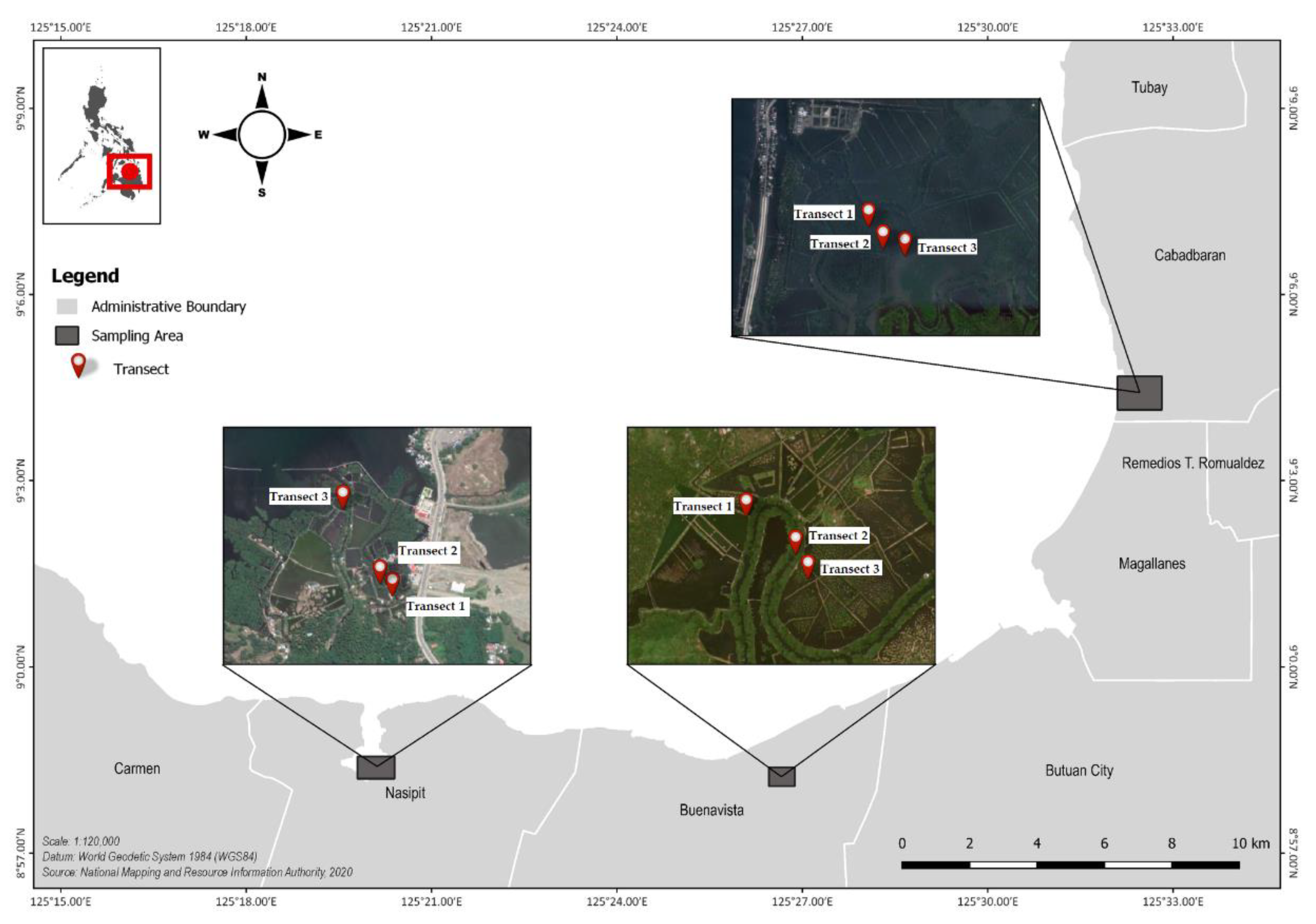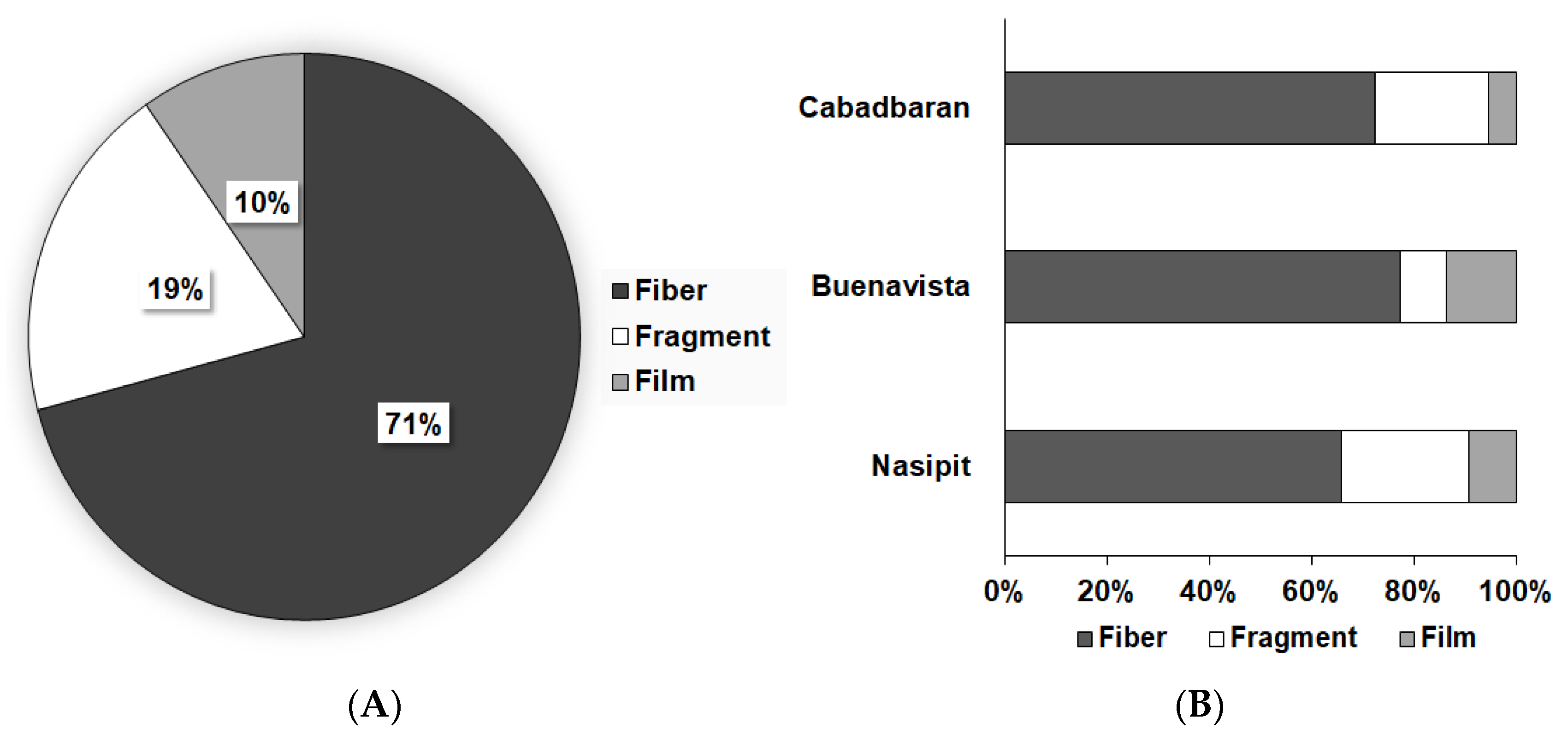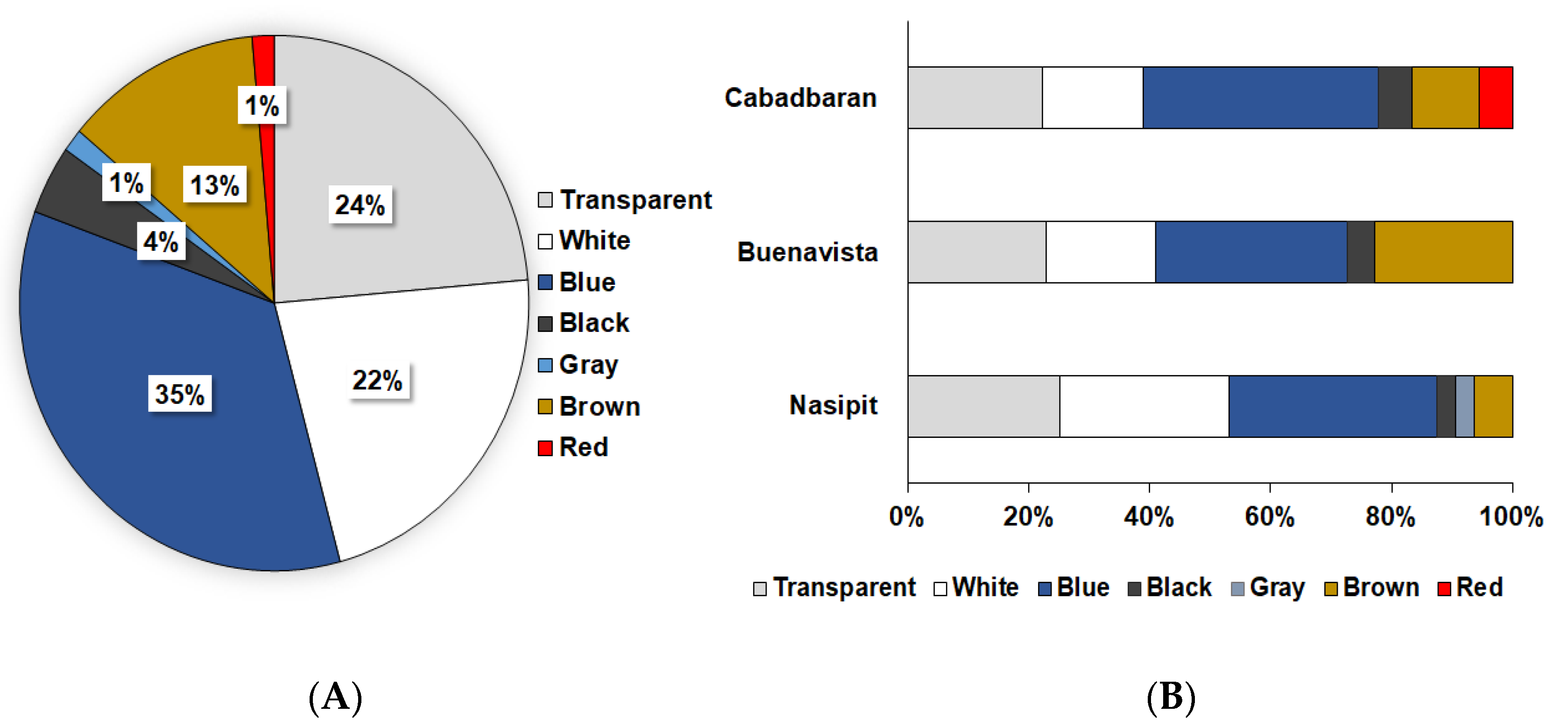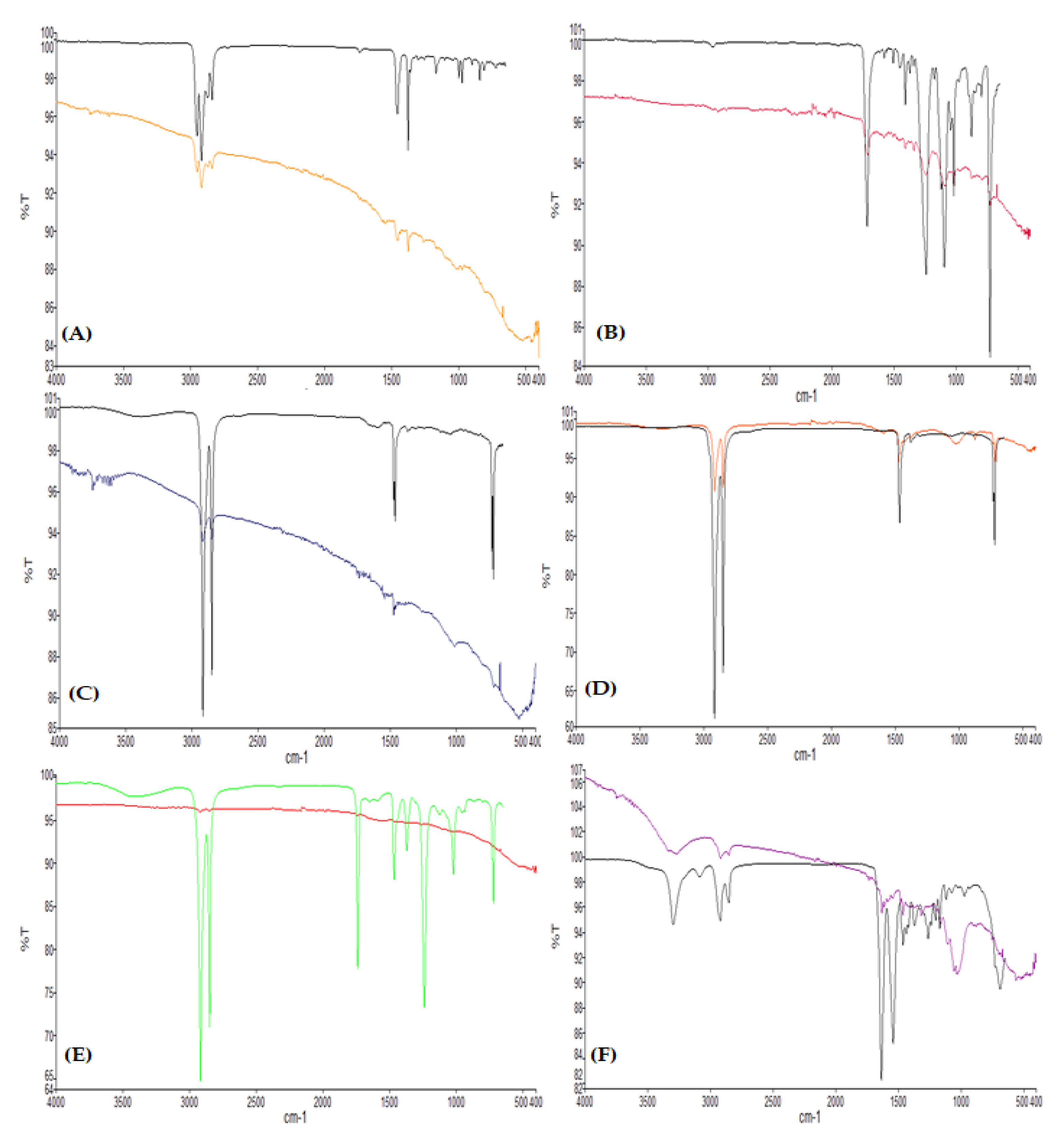Unraveling Microplastic Pollution in Mangrove Sediments of Butuan Bay, Philippines
Abstract
1. Introduction
2. Materials and Methods
2.1. Establishment of the Sampling Sites and Sediment Collection
2.2. Microplastic Extraction and Identification
2.3. Quality Control
2.4. Density of Plastic Litter
2.5. Statistical Analysis
3. Results
4. Discussion
5. Conclusions and Recommendations
Author Contributions
Funding
Institutional Review Board Statement
Informed Consent Statement
Data Availability Statement
Acknowledgments
Conflicts of Interest
References
- Derraik, J.G. The pollution of the marine environment by plastic debris: A review. Mar. Pollut. Bull. 2002, 44, 842–852. [Google Scholar] [CrossRef]
- Rios, L.M.; Moore, C.; Jones, P.R. Persistent organic pollutants carried by synthetic polymers in the ocean environment. Mar. Pollut. Bull. 2007, 54, 1230–1237. [Google Scholar] [CrossRef]
- Thompson, R.C.; Swan, S.H.; Moore, C.J.; Vom Saal, F.S. Our plastic age. Philos. Trans. R. Soc. B Biol. Sci. 2009, 364, 1973–1976. [Google Scholar] [CrossRef]
- Plastics Europe. Plastic waste: Ecological and Human Health Impacts. 2010. Available online: https://ec.europa.eu/environment/integration/research/newsalert/pdf/IR1_en.pdf (accessed on 15 August 2022).
- Geyer, R.; Jambeck, J.R.; Law, K.L. Production, use, and fate of all plastics ever made. Sci. Adv. 2017, 3, 1700782. [Google Scholar] [CrossRef]
- Van Sebille, E.; Wilcox, C.; Lebreton, L.; Maximenko, N.; Hardesty, B.D.; Van Franeker, J.A.; Law, K.L. A global inventory of small floating plastic debris. Environ. Res. Lett. 2015, 10, 124006. [Google Scholar] [CrossRef]
- Jambeck, J.R.; Geyer, R.; Wilcox, C.; Siegler, T.R.; Perryman, M.; Andrady, A.; Law, K.L. Plastic waste inputs from land into the ocean. Science 2015, 347, 768–771. [Google Scholar] [CrossRef]
- Meijer, L.; Van Emmerik, T.; Lebreton, L. Over 1000 rivers accountable for 80% of global riverine plastic emissions into the ocean. Sci. Adv. 2021, 7, eaaz5803. [Google Scholar] [CrossRef]
- Requiron, J.; Bacosa, R. Macroplastic Transport and Deposition in the Environs of Pulauan River. Philipp. J. Sci. 2022, 151, 1211–1220. [Google Scholar] [CrossRef]
- Gaboy, S.M.; Guihawan, J.Q.; Leopardas, V.M.; Bacosa, H.P. Unravelling macroplastic pollution in seagrass beds of Iligan City, Mindanao, Philippines. Mar. Pollut. Bull. 2022, 185, 114233. [Google Scholar] [CrossRef]
- Sajorne, R.E.; Cayabo, G.D.B.; Madarcos, J.R.V.; Madarcos, K.G.; Omar Jr, D.M.; Ardines, L.B.; Bacosa, H.P. Occurrence of COVID-19 personal protective equipment (PPE) litters along the eastern coast of Palawan Island, Philippines. Mar. Pollut. Bull. 2022, 182, 113934. [Google Scholar] [CrossRef]
- Inocente, S.A.T.; Bacosa, H.P. Assessment of macroplastic pollution on selected tourism beaches of Barobo, Surigao Del Sur, Philippines. J. Mar. Isl. Cult. 2022. Available online: https://jmic.online/ (accessed on 26 October 2022). [CrossRef]
- Acot, F.T.; Sajorne, R.E.; Omar, N.A.K.; Suson, P.D.; Rallos, L.E.E.; Bacosa, H.P. Unraveling macroplastic pollution in rural and urban beaches in Sarangani Bay Protected Seascape, Mindanao, Philippines. J. Mar. Sci. Eng. 2022, 10, 1532. [Google Scholar] [CrossRef]
- Eriksen, M.; Lebreton, L.C.; Carson, H.S.; Thiel, M.; Moore, C.J.; Borerro, J.C.; Reisser, J. Plastic pollution in the world’s oceans: More than 5 trillion plastic pieces weighing over 250,000 tons afloat at sea. PloS ONE 2014, 9, 111913. [Google Scholar] [CrossRef] [PubMed]
- Sajorne, R.E.; Bacosa, H.P.; Cayabo, G.D.B.; Ardines, L.B.; Sumeldan, J.D.; Omar, J.M.; Creencia, L.A. Plastic litter pollution along sandy beaches in Puerto 440 Princesa. Mar. Pollut. Bull. 2021, 169, 112520. [Google Scholar] [CrossRef]
- Akbay, İ.K.; Özdemir, T. Monomer migration and degradation of polycarbonate via UV-C irradiation within aquatic and atmospheric environments. J. Macromol. Sci. 2016, 53, 340–345. [Google Scholar] [CrossRef]
- Adhikari, P.L.; Bam, W.; Campbell, P.L.; Oberhaensli, F.; Metian, M.; Besson, M.; Swarzenski, P.W. Evaluating Microplastic Experimental Design and Exposure Studies in Aquatic Organisms. In Microplastic in the Environment: Pattern and Process; Springer: Berlin/Heidelberg, Germany, 2022; pp. 69–85. [Google Scholar]
- Chin, L.W.; Fung, T.H. Plastic in marine litter. In Plastics and the Environment; Hester, R.E., Harrison, R.M., Eds.; John Wiley & Sons: Hoboken, NJ, USA, 2018; pp. 21–59. [Google Scholar]
- Alimba, C.G.; Faggio, C. Microplastics in the marine environment: Current trends in environmental pollution and mechanisms of toxicological profile. Environ. Toxicol. Pharmacol. 2019, 68, 61–74. [Google Scholar] [CrossRef]
- Barboza, L.G.A.; Gimenez, B.C.G. Microplastics in the marine environment: Current trends and future perspectives. Mar. Pollut. Bull. 2015, 97, 5–12. [Google Scholar] [CrossRef]
- Cordova, M.R.; Riani, E.; Shiomoto, A. Microplastics ingestion by blue panchax fish (Aplocheilus sp.) from Ciliwung Estuary, Jakarta, Indonesia. Mar. Pollut. Bull. 2020, 161, 111763. [Google Scholar] [CrossRef]
- Guzzetti, E.; Sureda, A.; Tejada, S.; Faggio, C. Microplastic in marine organism: Environmental and toxicological effects. Environ. Toxicol. Pharmacol. 2018, 64, 164–171. [Google Scholar] [CrossRef]
- Adhikari, S.; Kelkar, V.; Kumar, R.; Halden, R.U. Methods and challenges in the detection of microplastics and nanoplastics: A mini-review. Polym. Int. 2022, 71, 543–551. [Google Scholar] [CrossRef]
- Barboza, L.G.A.; Vethaak, A.D.; Lavorante, B.R.; Lundebye, A.K.; Guilhermino, L. Marine microplastic debris: An emerging issue for food security, food safety and human health. Mar. Pollut. Bull. 2018, 133, 336–348. [Google Scholar] [PubMed]
- Purwiyanto, A.I.S.; Suteja, Y.; Ningrum, P.S.; Putri, W.A.E.; Agustriani, F.; Cordova, M.R.; Koropitan, A.F. Concentration and adsorption of Pb and Cu in microplastics: Case study in aquatic environment. Mar. Pollut. Bull. 2020, 158, 111380. [Google Scholar] [CrossRef] [PubMed]
- Walkinshaw, C.; Lindeque, P.K.; Thompson, R.; Tolhurst, T.; Cole, M. Microplastics and seafood: Lower trophic organisms at highest risk of contamination. Ecotoxicol. Environ. Saf. 2020, 190, 110066. [Google Scholar] [CrossRef]
- Cordova, M.R.; Ulumuddin, Y.I.; Purbonegoro, T.; Shiomoto, A. Characterization of microplastics in mangrove sediment of Muara Angke Wildlife Reserve, Indonesia. Mar. Pollut. Bull. 2021, 163, 112012. [Google Scholar] [CrossRef]
- Onda, D.F.L.; Gomez, N.C.F.; Purganan, D.J.E.; Tolentino, M.P.S.; Bitalac, J.M.S.; Calpito, J.V.M.; Viernes, A.C.A. Marine microbes and plastic debris: Research status and opportunities in the Philippines. Philipp. J. Sci. 2020, 149, 71–82. [Google Scholar]
- Cabrera, O.C.; Villanoy, C.L.; David, L.T.; Gordon, A.L. Barrier layer control of entrainment and upwelling in the Bohol Sea, Philippines. Oceanography 2011, 24, 130–141. [Google Scholar] [CrossRef]
- Primavera, J.; Tumanda Jr, M.I. The Agusan Marsh: A situationer with focus on scientific aspects. In Proceedings of the 1st Scientific Conference on the Agusan Marsh, Butuan City, Agusan del Norte, Philippines, 21–23 May 2007; UNESCO Jakarta Office, Philippine Council for Aquatic and Marine Research and Development: Los Baños, Philippines, 2008; pp. 5–14. [Google Scholar]
- Karami, A.; Golieskardi, A.; Choo, C.K.; Romano, N.; Ho, Y.B.; Salamatinia, B. A high-performance protocol for extraction of microplastics in fish. Sci. Total Environ. 2017, 578, 485–494. [Google Scholar] [CrossRef]
- Vianello, A.; Boldrin, A.; Guerriero, P.; Moschino, V.; Rella, R.; Sturaro, A.; Da Ros, L. Microplastic particles in sediments of Lagoon of Venice, Italy: First observations on occurrence, spatial patterns and identification. Estuar. Coast. Shelf Sci. 2013, 130, 54–61. [Google Scholar] [CrossRef]
- Su, L.; Xue, Y.; Li, L.; Yang, D.; Kolandhasamy, P.; Li, D.; Shi, H. Microplastics in Taihu Lake, 548 China. Env. Pollut. 2016, 216, 711–719. [Google Scholar] [CrossRef]
- Veerasingam, S.; Ranjani, M.; Venkatachalapathy, R.; Bagaev, A.; Mukhanov, V.; Litvinyuk, D.; Vethamony, P. Contributions of Fourier transform infrared spectroscopy in microplastic pollution research: A review. Crit. Rev. Environ. Sci. Technol. 2021, 51, 2681–2743. [Google Scholar] [CrossRef]
- Abreo, N.A.S.; Blatchley, D.; Superio, M.D. Stranded whale shark (Rhincodon typus) reveals the vulnerability of filter-feeding elasmobranchs to marine litter in the Philippines. Mar. Pollut. Bull. 2019, 141, 79–83. [Google Scholar] [CrossRef]
- Espiritu, E.Q.; Dayrit, S.A.S.; Coronel, A.S.O.; Paz, N.S.C.; Ronquillo, P.I.L.; Castillo, V.C.G.; Enriquez, E.P. Assessment of quantity and quality of microplastics in the sediments, waters, oysters, and selected fish species in key sites along the Bombong estuary and the coastal waters of Ticalan in San Juan, Batangas. Philipp. J. Sci. 2019, 148, 789–801. [Google Scholar]
- Rahim, S.; Widayati, W.; Analuddin, K.; Saleh, F.; Sahar, S. Spatial distribution of marine debris pollution in mangrove-estuaries ecosystem of Kendari Bay. IOP Conf. Ser. Earth Environ. Sci. 2020, 412, 012006. [Google Scholar] [CrossRef]
- Egessa, R.; Nankabirwa, A.; Ocaya, H.; Pabire, W.G. Microplastic pollution in surface water of Lake Victoria. Sci. Total Environ. 2020, 741, 140201. [Google Scholar] [CrossRef]
- Nor, N.H.M.; Obbard, J.P. Microplastics in Singapore’s coastal mangrove ecosystems. Mar. Pollut. Bull. 2014, 79, 278–283. [Google Scholar]
- Zhou, Q.; Tu, C.; Fu, C.; Li, Y.; Zhang, H.; Xiong, K.; Luo, Y. Characteristics and distribution of microplastics in the coastal mangrove sediments of China. Sci. Total Environ. 2020, 703, 134807. [Google Scholar]
- Frère, L.; Paul-Pont, I.; Rinnert, E.; Petton, S.; Jaffré, J.; Bihannic, I.; Huvet, A. Influence of environmental and anthropogenic factors on the composition, concentration and spatial distribution of microplastics: A case study of the Bay of Brest (Brittany, France). Environ. Pollut. 2017, 225, 211–222. [Google Scholar] [CrossRef]
- Yonkos, L.T.; Friedel, E.A.; Perez-Reyes, A.C.; Ghosal, S.; Arthur, C.D. Microplastics in four estuarine rivers in the Chesapeake Bay, USA. Environ. Sci. Technol. 2014, 48, 14195–14202. [Google Scholar] [CrossRef]
- Song, Y.K.; Hong, S.H.; Eo, S.; Jang, M.; Han, G.M.; Isobe, A.; Shim, W.J. Horizontal and vertical distribution of microplastics in Korean coastal waters. Environ. Sci. Technol. 2018, 52, 12188–12197. [Google Scholar] [CrossRef]
- Naji, A.; Nuri, M.; Amiri, P.; Niyogi, S. Small microplastic particles (S-MPPs) in sediments of mangrove ecosystem on the northern coast of the Persian Gulf. Mar. Pollut. Bull. 2019, 146, 305–311. [Google Scholar] [CrossRef]
- Thompson, R.C.; Olsen, Y.; Mitchell, R.P.; Davis, A.; Rowland, S.J.; John, A.W.; Russell, A.E. Lost at sea: Where is all the plastic? Science 2004, 304, 838. [Google Scholar] [CrossRef]
- Claessens, M.; De Meester, S.; Van Landuyt, L.; De Clerck, K.; Janssen, C.R. Occurrence and distribution of microplastics in marine sediments along the Belgian coast. Mar. Pollut. Bull. 2011, 62, 2199–2204. [Google Scholar] [CrossRef]
- Kazmiruk, T.N.; Kazmiruk, V.D.; Bendell, L.I. Abundance and distribution of microplastics within surface sediments of a key shellfish growing region of Canada. PLoS ONE 2018, 13, 0196005. [Google Scholar] [CrossRef]
- Catarino, A.I.; Thompson, R.; Sanderson, W.; Henry, T.B. Development and optimization of a standard method for extraction of microplastics in mussels by enzyme digestion of soft tissues. Environ. Toxicol. Chem. 2017, 36, 947–951. [Google Scholar] [CrossRef]
- Leslie, H.A.; Brandsma, S.H.; Van Velzen, M.J.M.; Vethaak, A.D. Microplastics en route: Field measurements in the Dutch river delta and Amsterdam canals. Environ. Int. 2017, 101, 133–142. [Google Scholar]
- Renzi, M.; Guerranti, C.; Blašković, A. Microplastic contents from maricultured and natural mussels. Mar. Pollut. Bull. 2018, 131, 248–251. [Google Scholar] [CrossRef]
- Cho, Y.; Shim, W.J.; Jang, M.; Han, G.M.; Hong, S.H. Abundance and characteristics of microplastics in market bivalves from South Korea. Environ. Pollut. 2019, 245, 1107–1116. [Google Scholar] [CrossRef]
- Peng, G.; Zhu, B.; Yang, D.; Su, L.; Shi, H.; Li, D. Microplastics in sediments of the Changjiang Estuary, China. Environ. Pollut. 2017, 225, 283–290. [Google Scholar] [CrossRef]
- Ugwu, K.; Herrera, A.; Gómez, M. Microplastics in marine biota: A review. Mar. Pollut. Bull. 2021, 169, 112540. [Google Scholar] [CrossRef]
- Worby, C.J.; Chang, H.H. Face mask use in the general population and optimal resource allocation during the COVID-19 pandemic. Nat. Commun. 2020, 11, 1–9. [Google Scholar]
- Chen, X.; Chen, X.; Liu, Q.; Zhao, Q.; Xiong, X.; Wu, C. Used disposable face masks are significant sources of microplastics to environment. Environ. Pollut. 2021, 285, 117485. [Google Scholar] [CrossRef]
- Setälä, O.; Lehtiniemi, M.; Coppock, R.; Cole, M. Microplastics in marine food webs. In Microplastic Contamination in Aquatic Environments; Zeng, E.Y., Ed.; Elsevier: Amsterdam, The Netherlands, 2018; pp. 339–363. [Google Scholar]
- Li, J.; Qu, X.; Su, L.; Zhang, W.; Yang, D.; Kolandhasamy, P.; Shi, H. Microplastics in mussels along the coastal waters of China. Environ. Pollut. 2016, 214, 177–184. [Google Scholar] [CrossRef]
- Lusher, A.; Hollman, P.; Mendoza-Hill, J. Microplastics in Fisheries and Aquaculture: Status of Knowledge on Their Occurrence and Implications for Aquatic Organisms and Food Safety; FAO: Rome, Italy, 2017. [Google Scholar]
- Jang, M.; Shim, W.J.; Cho, Y.; Han, G.M.; Song, Y.K.; Hong, S.H. A close relationship between microplastic contamination and coastal area use pattern. Water Res. 2020, 171, 115400. [Google Scholar] [CrossRef]
- Chowdhury, M.J.; Nasrin, S.; Al Faruque, M.A. Significance of agro-textiles and future prospects in Bangladesh. Eur. Sci. J. 2017, 13, 10–19. [Google Scholar] [CrossRef]
- Poeta, G.; Fanelli, G.; Pietrelli, L.; Acosta, A.T.; Battisti, C. Plastisphere in action: Evidence for an interaction between expanded polystyrene and dunal plants. Environ. Sci. Pollut. Res. 2017, 24, 11856–11859. [Google Scholar] [CrossRef]






| Sampling Area | Transect No. | Coordinates | No. of MPs before FTIR/150 g Sediments | No. of Confirmed MPs after FTIR/150 g Sediments | Microplastic Density (No. of MPs/kg Sediment) |
|---|---|---|---|---|---|
| Cabadbaran | Transect 1 | 9°4′19″ N, 125°32′29″ E | 17 | 9 | 60.0 |
| Transect 2 | 8°4′20″ N, 125°32′26″ E | 8 | 5 | 33.3 | |
| Transect 3 | 8°4′23″ N, 125°32′24″ E | 12 | 4 | 26.7 | |
| Buenavista | Transect 1 | 8°58′16″ N, 125°26′37″ E | 18 | 10 | 66.7 |
| Transect 2 | 8°58′13″ N, 126°26′41″ E | 14 | 9 | 60.0 | |
| Transect 3 | 8°58′16″ N, 125°26′37″ E | 10 | 3 | 20.0 | |
| Nasipit | Transect 1 | 8°58′19″ N, 125°20′12″ E | 21 | 10 | 66.7 |
| Transect 2 | 8°58′20″ N, 125°20′11″ E | 20 | 9 | 60.0 | |
| Transect 3 | 8°58′26″ N, 125°20′8″ E | 21 | 13 | 86.7 |
| Study Area | MP Particle/kg | Reference |
|---|---|---|
| Cabadbaran, Philippines | 40.0 | This study |
| Buenavista, Philippines | 48.9 | This study |
| Nasipit, Philippines | 71.1 | This study |
| Changi, Singapore | 9.7 | Nor and Obbard, 2014 [39] |
| Bandar Lengeh, Iran | 34.5 | Naji et al., 2019 [44] |
| Fujian, China | 198.4 | Zhou et al., 2020 [40] |
| Muara Angke Wildlife Reserve, Indonesia | 28.09 | Cordova et al., 2021 [27] |
Publisher’s Note: MDPI stays neutral with regard to jurisdictional claims in published maps and institutional affiliations. |
© 2022 by the authors. Licensee MDPI, Basel, Switzerland. This article is an open access article distributed under the terms and conditions of the Creative Commons Attribution (CC BY) license (https://creativecommons.org/licenses/by/4.0/).
Share and Cite
Navarro, C.K.P.; Arcadio, C.G.L.A.; Similatan, K.M.; Inocente, S.A.T.; Banda, M.H.T.; Capangpangan, R.Y.; Torres, A.G.; Bacosa, H.P. Unraveling Microplastic Pollution in Mangrove Sediments of Butuan Bay, Philippines. Sustainability 2022, 14, 14469. https://doi.org/10.3390/su142114469
Navarro CKP, Arcadio CGLA, Similatan KM, Inocente SAT, Banda MHT, Capangpangan RY, Torres AG, Bacosa HP. Unraveling Microplastic Pollution in Mangrove Sediments of Butuan Bay, Philippines. Sustainability. 2022; 14(21):14469. https://doi.org/10.3390/su142114469
Chicago/Turabian StyleNavarro, Carl Kenneth P., Cris Gel Loui A. Arcadio, Kaye M. Similatan, Sherley Ann T. Inocente, Marybeth Hope T. Banda, Rey Y. Capangpangan, Armi G. Torres, and Hernando P. Bacosa. 2022. "Unraveling Microplastic Pollution in Mangrove Sediments of Butuan Bay, Philippines" Sustainability 14, no. 21: 14469. https://doi.org/10.3390/su142114469
APA StyleNavarro, C. K. P., Arcadio, C. G. L. A., Similatan, K. M., Inocente, S. A. T., Banda, M. H. T., Capangpangan, R. Y., Torres, A. G., & Bacosa, H. P. (2022). Unraveling Microplastic Pollution in Mangrove Sediments of Butuan Bay, Philippines. Sustainability, 14(21), 14469. https://doi.org/10.3390/su142114469










